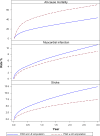Lower extremity amputation in peripheral artery disease: improving patient outcomes
- PMID: 25075192
- PMCID: PMC4107174
- DOI: 10.2147/VHRM.S50588
Lower extremity amputation in peripheral artery disease: improving patient outcomes
Abstract
Peripheral artery disease affects over eight million Americans and is associated with an increased risk of mortality, cardiovascular disease, functional limitation, and limb loss. In its most severe form, critical limb ischemia, patients are often treated with lower extremity (LE) amputation (LEA), although the overall incidence of LEA is declining. In the US, there is significant geographic variation in the performing of major LEA. The rate of death after major LEA in the US is approximately 48% at 1 year and 71% at 3 years. Despite this significant morbidity and mortality, the use of diagnostic testing (both noninvasive and invasive testing) in the year prior to LEA is low and varies based on patient, provider, and regional factors. In this review we discuss the significance of LEA and methods to reduce its occurrence. These methods include improved recognition of the risk factors for LEA by clinicians and patients, strong advocacy for noninvasive and/or invasive imaging prior to LEA, improved endovascular revascularization techniques, and novel therapies.
Keywords: lower extremity amputation; mortality; peripheral artery disease.
Figures



References
-
- Rooke TW, Hirsch AT, Misra S, et al. 2011 ACCF/AHA Focused Update of the Guideline for the Management of Patients with Peripheral Artery Disease (updating the 2005 guideline): a report of the American College of Cardiology Foundation/American Heart Association Task Force on Practice Guidelines. J Am Coll Cardiol. 2011;58(19):2020–2045. - PMC - PubMed
-
- Tendera M, Aboyans V, Bartelink ML, et al. ESC guidelines on the diagnosis and treatment of peripheral artery diseases: document covering atherosclerotic disease of extracranial carotid and vertebral, mesenteric, renal, upper and lower extremity arteries: the Task Force on the Diagnosis and Treatment of Peripheral Artery Diseases of the European Society of Cardiology (ESC) Eur Heart J. 2011;32(22):2851–2906. - PubMed
-
- Heald CL, Fowkes FG, Murray GD, Price JF. Risk of mortality and cardiovascular disease associated with the ankle-brachial index: systematic review. Atherosclerosis. 2006;189(1):61–69. - PubMed
Publication types
MeSH terms
Substances
LinkOut - more resources
Full Text Sources
Other Literature Sources
Medical

